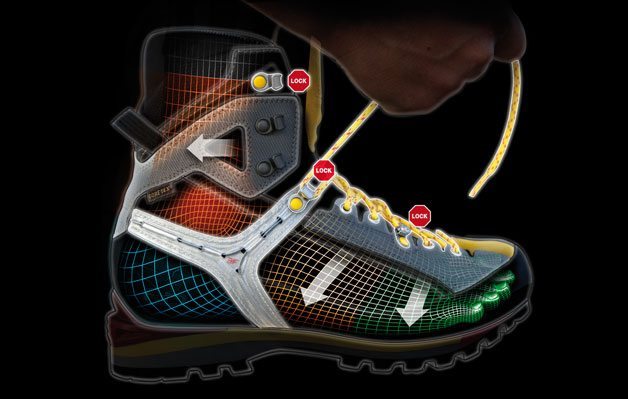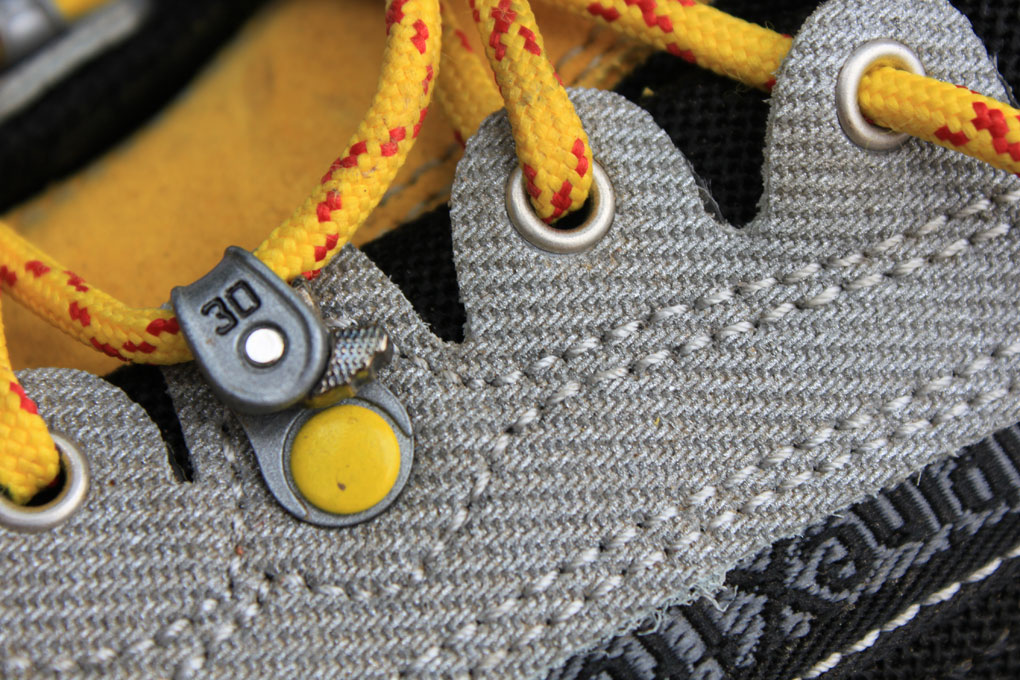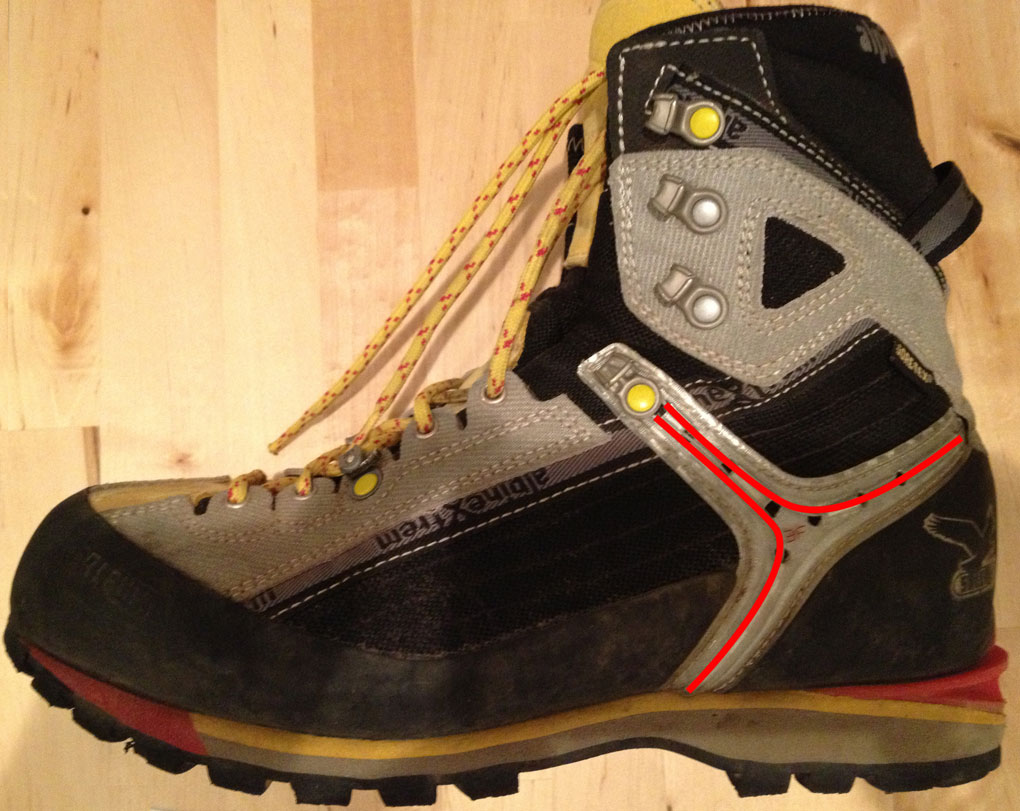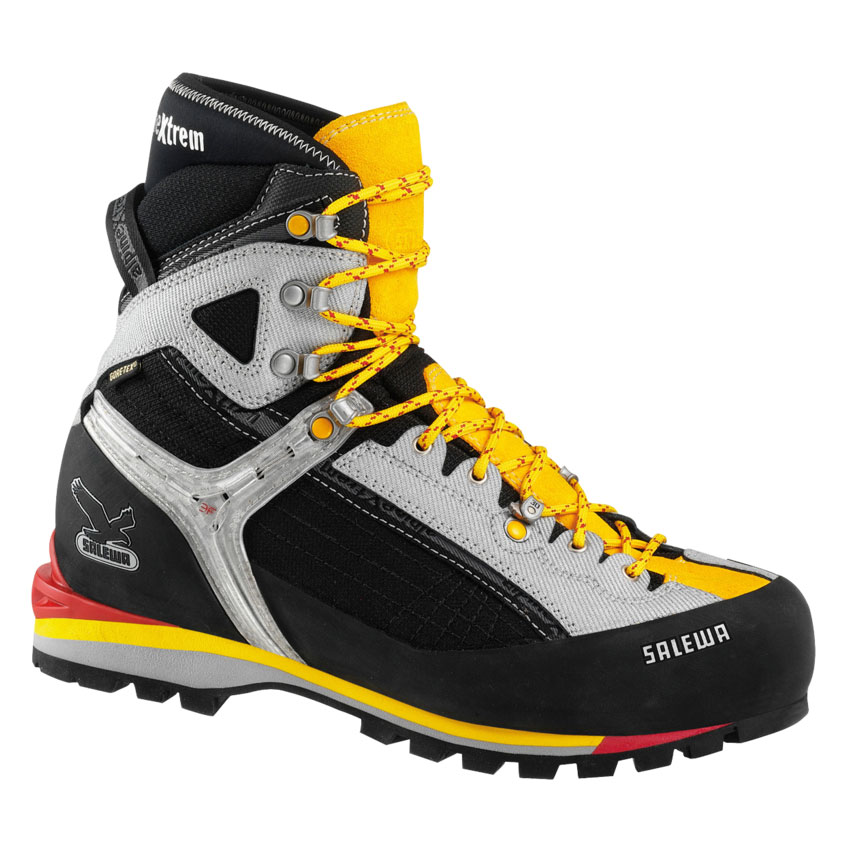Size: 40.5 EU, standard width
Weight (g): 800 g (pair)
Sizing 6–13 (half sizes)
Insole Stiff, Nylon + 27% Fiberglass
Upper: Synthetic upper with leather inserts, 360 full rubber rand
My foot: narrow (A width) with high instep, medium volume
Conditions tested: Steep snow/ice front-pointing and kicking steps, 4th class climbing/summer mountaineering, backpacking
Days used: ~30
Miles worn: ~100
MSRP: $329
Salewa’s line of technical mountaineering and trekking footwear is starting to draw more attention in the U.S. The word on the street: Salewa makes solid, quality boots that can go head-to-head with the big names in Italian mountaineering footwear.
Materials / Design
The Raven Combi GTX is one of Salewa’s mountaineering boots marketed for “technical alpine routes and trekking and backpacking on challenging terrain.”
The Raven has a Vibram Mulaz sole with “Climb Zone,” which is also featured on many of the competing boots in this category. It is stiffened with a 73% nylon, 27% fiberglass insole that runs the full length of the boot. The insole is sandwiched between the sole and a few layers of stiff foam that form the sidewalls of the sole. The boot has a full wrap rubber rand and a plastic lug on the heel for semi-automatic crampon compatibility.
The upper is almost entirely synthetic, except for some of the tongue and a small bit on the toe, which are leather. The Raven is fully lined with a Gore-Tex waterproof/breathable membrane and is lightly insulated.
The top of the Raven is trimmed in neoprene designed to serve as a makeshift gator—the way it is sewn allows the neoprene to hug the calf/ankle area. This seems like a fine idea, but the combination of trim and stitching around the top of the neoprene takes away almost all of the natural stretch in the material. This means that if you have bigger calves or ankles, the gator might be uncomfortably tight around your legs. (I have smaller calves, and this was not an issue.)
Fit / Sizing
I am one of those people who tends to get blisters very easily. When my climbing partners need 3-4 days to break in new boots, I’ll take 3-4 weeks. So one of my favorite things about the Raven has been the out-of-box fit.
During the testing period, I made no modifications to the boots. Even using the stock insoles, I’ve never encountered a blister and only had passing acquaintance with hot-spots. I suspect the relatively large toe box and snug heel pocket are major contributors to my blister-free experience.
The toe box is both structured and rigid, like many mountaineering boots, but it is very high volume. Compared to my La Sportiva Trango S EVO’s, which have a much lower-volume toe box (to increase climbing performance), the toe box on the Raven’s feel like Giant’s Stadium. While some climbing performance is sacrificed with the roomier toe box, in a boot that I often wear for 12-plus-hour stretches, it is a tradeoff I am willing to make.
The sole is both thicker and stiffer than a typical climbing shoe. I would say that the Ravens, though noticeably less precise than my Trango’s, climb very well. Scrambling 4th class and low 5th class on rotten rock in the Maroon Bells, I never felt concerned about the performance of these boots.
The heel pocket on the Raven Combi holds my heel securely; I get almost no heel lift at all. It also allows my foot a very natural range of motion (more on this below). In my Trango’s, when I am laced tight enough to keep my heel in place, my ankle feels almost locked in place. But on the Raven’s, I have a much greater range of motion and a better heel pocket fit.
Overall, the Raven Combi fits generally true to size. My size 40.5 feels right on size-wise.
Features
The Raven has what Salewa calls their “3D System EVO,” which is intended to give a bit more versatility in how tight you can lace different areas of the boot, for better comfort and performance. This works by using two different types of lace locks at various places on the boot.

The first style of lace lock, which holds the lace via a spring-loaded lever system, is located at what corresponds to the 3rd lace-eyelet position (moving from the toes up). It works like a one-way ratchet system and it locks automatically as the laces are pulled tight. To unlock the lace, you have to press a very small lever on the lock.

The second style of lace locks (located at the 6th and 9th eyelet positions) is similar to those found on many hiking/mountaineering boots: “hooks” that pinch the lace into a narrowing channel. The particular boot that I tested did not have a lace lock in the 9th eyelet position; there is just a non-locking “hook” in this position.
The first lace lock is so low that tightening the laces below it just reduces the toe box volume; it doesn’t really secure the boot any more to my foot. (Depending on the shape of your foot, however, this feature could be useful.)
Overall, the 3D System Evo works; the design locks the laces well. But I found that the primary benefit of the 3D system isn’t the versatility in how tight I can make certain sections of the boot, it’s that once I found a good fit, I’ve seldom had to readjust the lower laces (i.e. below the 3rd eyelet).
Other than one durability issue (described more below), the only other issue I have had with the 3D system is that, if I ever needed to, it can be difficult to disengage the spring-loaded lace locks, especially with gloves on.
The Raven also features Salewa’s “3F System EVO” technology (not to be confused with the aforementioned “3D System EVO”). The 3F EVO is a cable system that integrates the ankle lace lock (i.e. 6th eyelet) with the heel pocket on the boot to give a more natural range of motion while still keeping your heel firmly in the heel pocket.
There are three sections of cable that make up the 3F system. The primary cable runs from the outside (lateral) ankle lace-lock, around the top of the heel pocket, and ends at the inner (medial) side ankle lace-lock. The other two cables run from each of the ankle lace-locks to the sole of the boot, just in front of the heel pocket.

The cables are routed around the boot by a sturdy, clear, plastic and fabric scaffold system. The cables all appear to be “activated” (i.e. tensioned) by tightening the laces. (There is no way to tighten the cables otherwise.) The purpose of the cables (though not explicitly stated by Salewa) seems to be to redistribute the force generated by lacing your boot to key areas around the heel pocket. This is supposed to increase range of motion and heel retention at the same time.
The 3F System EVO performs as advertised: the Raven’s have a great range of motion while maintaining great heel pocket hold. Whether it performs as intended may be a different story. Allow me to explain…
The cable portion of the 3F system appears not to contribute to the system’s functionality. Even when I lace the boot as tight as I can—thus “activating” the cables—the cables remain slack. All of the force of the lacing is distributed through the plastic/fabric scaffold that holds the cables in place, but apparently not by the cables themselves. But the plastic/fabric scaffold for the cables is relatively stiff and follows the cables across the boot. Therefore, the force of lacing up the boot is likely still being redistributed along the same path the cables take, achieving a similar result to the cables actually tightening. This idea is corroborated by a quick look through some of Salewa’s other less technical boots where the 3F system has no cables.
Also, I have never worn a boot that was this stiff that had this great of a heel pocket fit and great range of motion. Though it seems like the 3F System EVO doesn’t work exactly as it is intended, the boots do exhibit all of the advertised features attributed to this technology.


How would you rate this boot for climbing mont blanc obviously using winter socks plus neoprene socks ?? would it be cold on my feet ????
Hey Jordan,
I have never climbed Mont Blanc, so I cannot say for certain how the Ravens would perform warmth wise. Technically I think they will be great though. I think it mostly depends on how warm/cold your feet run. Like I mentioned, this boot does not have as much insulation as some of its competitors, so if your feet tend to run warm, you may be fine. But if your feet tend to run colder, this boot might be a touch cold.
Sorry I couldn’t be more specific!
-Sam
How suitable would you rate these boots for summer scrambling / mountain walking in Snowdonia, Cairngorms etc ?
Marc
Hi Marc,
Although I have never climbed in the UK, judging from a little internet research I would say the Raven’s might be a bit overkill. Unless you are planning to use crampons at somepoint, I would definitely suggest a boot without a full shank. I think the Ravens would be much better suited for 3 season mountaineering in the Alps.
Scrambling/mountain walking sounds like a climbing approach shoe might be a good option, especially if you plan on doing more scrambling than hiking,
Thanks,
Sam
Hello, I am looking for a solid boot for scottish ice climbing, and for larger routes in the Alps, I currently use the Rapace, and took them up mont blanc, of which my feet froze of course, I was wondering if this boot was a good choice?
Hey Joss,
I think it probably depends what the primary use for the boot will be. If it’s mostly for ice climbing, maybe something that will take automatic crampons would be better. If it’s primarily for the Alps, this would probably be a good choice. For really long routes in he alps, an overbook might be helpful.
I hope that answers your questions.
Sam
Hello everybody,
can i use these boots for climbing Mont Blan ?
Hi,
I am planning to climb Orizba in Mexico in early 2017. I am new to this and looking for boots that I can take there. I was told I’ll need crampons. Do you think these boots are a good option?
I think these boots are a great options for Orziba. This should be good level of warmth for tropical high peaks and if you are on one of the standard routes, the Raven should be plenty stiff for using crampons in steep snow. Just make sure you try them on in a shop and that they fit well, then break them in!
Hello everybody,
Can I use these boots for climbing Damavand in Iran ?
Hi Hasna,
Though I have no experience with this specific peak or region, I think the Raven could be a good choice if you tend to have warm feet. If you have poor circulation in your feet or otherwise tend to get cold feet easier than others in general, it might be a good idea to get a slightly warmer boot.
Good luck with your ascent!
Sam
Hello,
I already have a pair and climbed Mt. Adams WA Aug 2017. They worked perfectly for that condition. I plan on climbing Mt. Rainier Aug/Sept 2018. I want to use my own boots but not sure if they are adequate. Appreciate any advice. My feet may get cold just like any body but not in particular.
Hey Tim, I climbed Rainier last spring and can definitely say that Mont Blanc was colder (at least for the times I’ve been on the peak).
The Raven is perfect for peaks like Rainier and Mont Blanc. You shouldn’t have a problem.
Congrats on Adams!!
Hi,
I used the latest design raven 3 this week to climb Mt Rolleston, Arthurs pass NZ, absolutely loved them but unfortunately the 3F cable system thingy on both boots failed, the cables pulled out from the side of the boot.